A Private Tour today, in North Norfolk, looking for spring migrants. It was rather grey and cloudy for most of the day with the odd brighter interval, and decidedly cool for May in the light-moderate NE wind, but at least it stayed dry all day until after we had finished.
Our first destination for the morning was Kelling. As we got out of the minibus in the village, we could hear Greenfinches singing in the trees and saw two perched in the top of a pine tree. Walking down the lane, a Tawny Owl hooted once, a bit of a surprise, but some birds will hoot in the daytime. We didn’t hear it again, but a distant Lesser Whitethroat was rattling away on the hillside, and Blackcap and Common Whitethroat were singing from the hedge beside the track. Down at the copse, a Chiffchaff was chiffing and chaffing.
We stopped at the gate overlooking the Water Meadow and scanned the fields. A pair of Grey Partridges were hiding in the grass. We could see the male’s orange face and just see the back of the female, which was keeping well tucked down amongst the tussocks where the cows had been grazing.
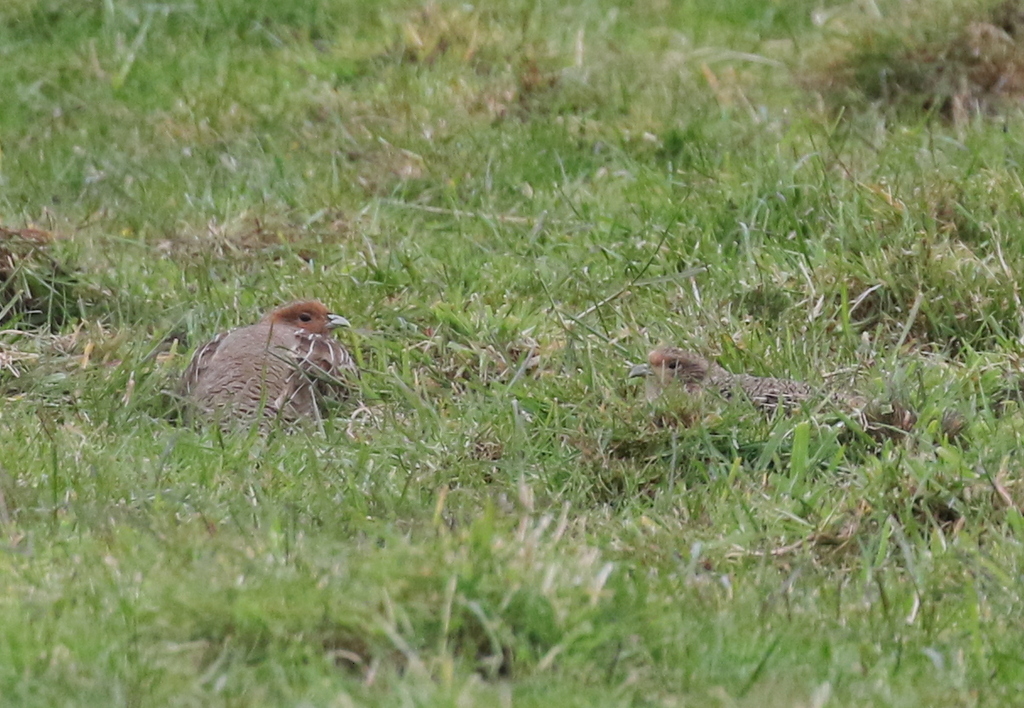
There were lots of Brown Hares feeding on the grassy hillside beyond the Water Meadow and a couple more very skittish individuals kept running in and out of view just in front of us. We couldn’t see the Ring Ouzel though – it had apparently been disturbed and flown back into the rushes out in the middle.
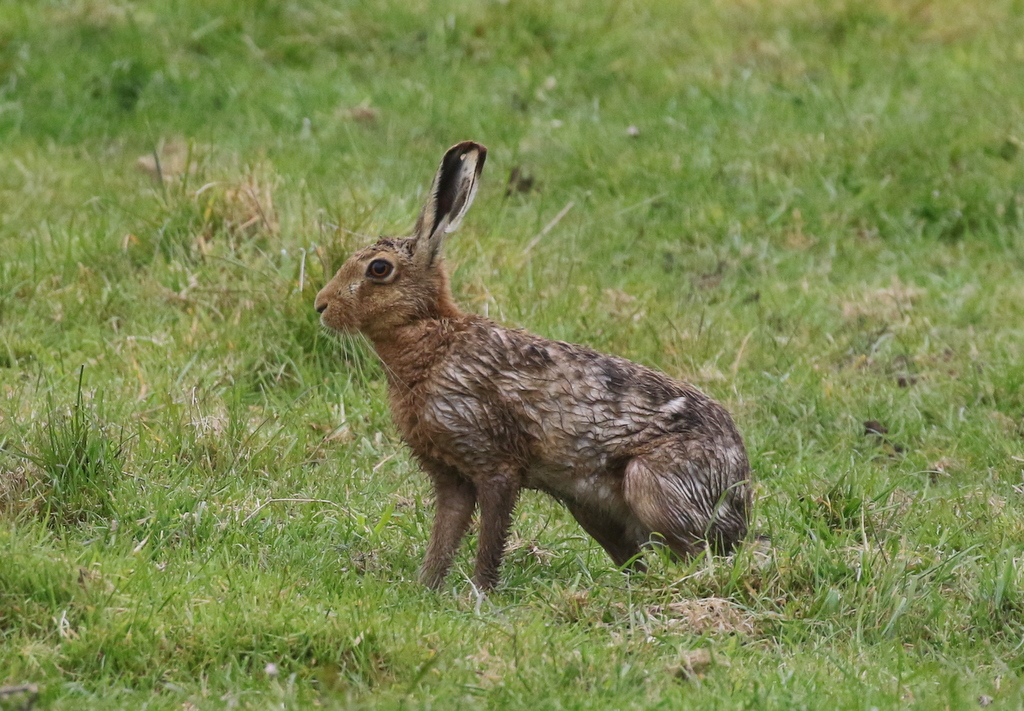
Continuing on, we had a nice view of a Common Whitethroat which perched up in the brambles beside the track, singing. From the cross-track, we stopped to scan the Water Meadow. There were lots of Sand Martins hawking low over the water, with one or two landing on the barbed wire fence from time to time. A Common Sandpiper was bobbing along the muddy margin of the pool towards the back, and a pair of Lapwings were feeding in the grass nearby, with the resident pair of Egyptian Geese.
Down past the Quags. a Sedge Warbler was half singing from the reeds in the ditch but refused to show itself. There were several Linnets in the brambles and we stopped to admire one smart red-breasted male in the scope. As we walked up the hillside beyond, we could hear Meadow Pipits and Skylarks singing, and watched one of the former doing its parachute display flight. A male Stonechat was perched on the fence further up.
We walked up to the top of the hill and looked back down to the back of the Water Meadow, but all it produced was a pair of Red-legged Partridges. It was a bit fresh in the breeze up here, so we turned to walk back. A female Wheatear appeared now on the concrete wall around the gun emplacements, before dropping down out of view.
Back at the Water Meadow, we watched some of the local Rooks feeding their recently fledged young around the edge of the pool. An Avocet flew in straight past us and landed in the shallow water. As we walked back up the lane, the Lesser Whitethroat was still singing from somewhere off in the hedge to the east, just audible from where we were. It was asked if we could get closer to try to hear it better, but typically by the time we had walked round it had gone quiet.
We made our way round to the Visitor Centre at Cley to warm up over a hot drink next. Four Whimbrel flew over calling as we got out of the minibus. From the cafe, we could see lots of Swifts and House Martins hawking low over the reeds. One or two Marsh Harriers circled up out of the reedbed.
Afterwards, we headed out to the hides. As we walked along the path, we could hear Reed Warblers singing from the reeds along the edge of the ditch. The first remained stubbornly hidden, but the second was perched up nicely on a bent reed, in full view, where we could get a really good look at it.

Out at boardwalk, the Swifts were zooming back and forth very low over the hides, just above our heads. A Sedge Warbler was singing from just outside Teal Hide, and we could just see it perched briefly on the fence in between the bushes before it dropped down out of view.
We went into Dauke’s Hide first. The Temminck’s Stints have been on Simmond’s Scrape and sure enough we found two of them straight away, on the near edge of the nearest island. We had a really good view of them creeping around on the edge of the mud. There had been five earlier, but we couldn’t find any sign of the other three at the moment, but two was plenty for us!
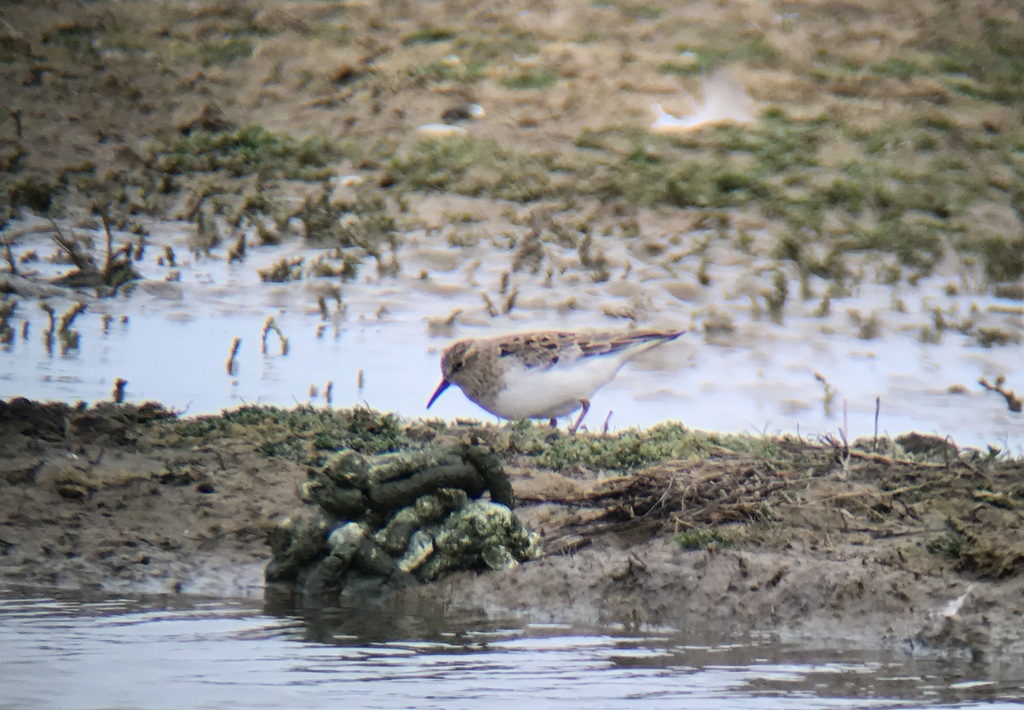
Temminck’s Stints are scarce migrants here, passing through in small numbers in early May from their wintering grounds in Africa to Scandinavia for the breeding season, so they are always good birds to catch up with. There were also several Black-tailed Godwits on Simmond’s Scrape, but they were mostly asleep, roosting on one of the islands, and a few Redshanks. A Ringed Plover was bathing in the shallow water by one of the islands towards the back, and there was a Little Ringed Plover too but it was rather mobile today. Several Avocets were hunkered down, nesting on the back of Whitwell Scrape.
There was a nice variety of ducks here too, with several lingering Wigeon and Teal of note. They are both common here in the winter, but most have long since departed now for their breeding grounds further east on the continent. A pair of Common Pochard on Whitwell Scrape may well be breeding somewhere here, as we watched the male shepherding the female while she fed, before flying off together. The drake then returned alone and, after a quick preen, went to sleep.

We went round to Teal Hide next to have a closer look at Pat’s Pool. A Little Ringed Plover flew past as we got inside and opened the flaps. There were several Black-tailed Godwits, these ones awake and feeding in front of the hide. They included one or two in breeding plumage, with rusty head, neck and breast. A single Common Sandpiper was feeding around the edge of the more distant island over towards Bishop Hide.
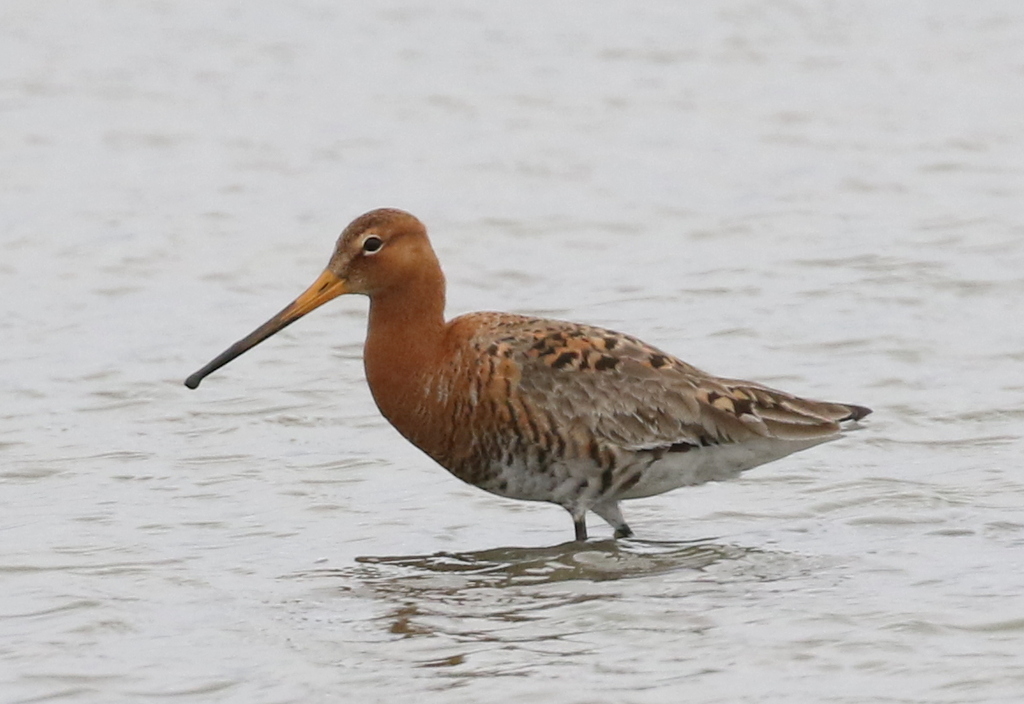
It was time for lunch now, so we made our way back towards the Visitor Centre. A Sedge Warbler was singing in the top of a bush in the reeds by the boardwalk now and seemed completely unphased by us stopping to watch it just a few feet away. We had a great view, very different from the Reed Warbler we had seen on the way out. As well as the different song, much less rhythmical, the Sedge Warbler had a bold pale supercilium. bordered with dark above, and more patterned upperparts.
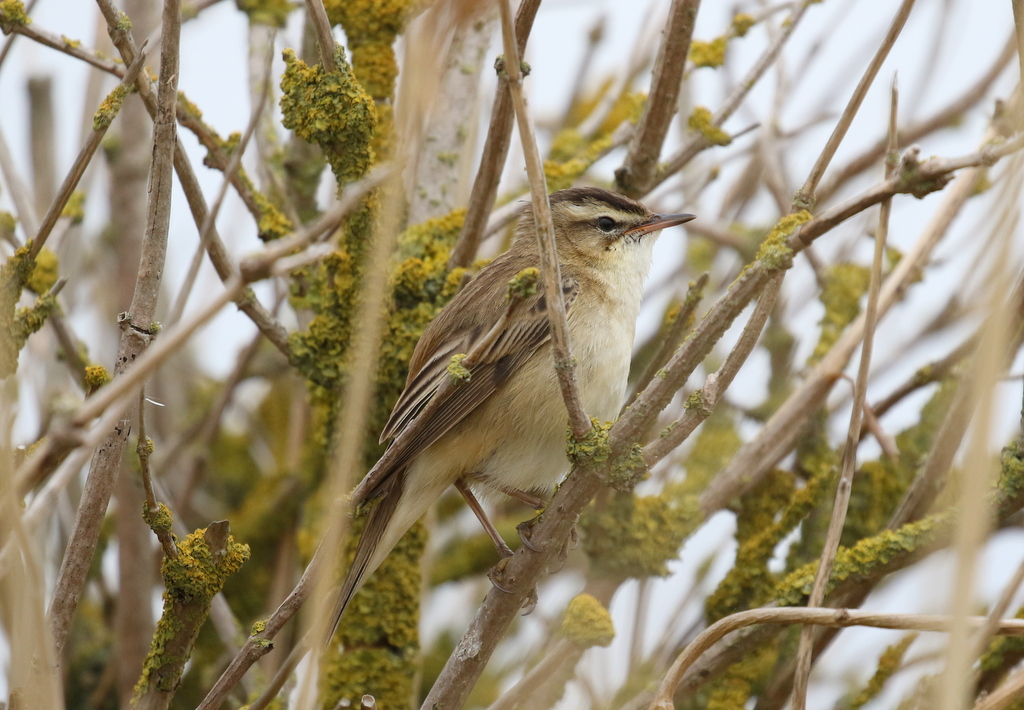
It was a bit too chilly to use the picnic tables at the Visitor Centre today, so we made our way round to the beach for lunch in the shelter. Afterwards, we had a quick look out at the sea. Two Little Terns flew past just offshore and a Sandwich Tern was perched on the post of the old wreck. Through the scope, we could see its shaggy crest and yellow-tipped black bill. It was a bit cold out on the beach, so beat a quick retreat.
We drove back round to Walsey Hills. A female Common Pochard was diving with two ducklings on the pool as we got out, a rare breeder here so always good to see them with young. As we walked in through the bushes, there were lots of Chaffinches, and tits including a Coal Tit, coming in to the feeders. Just beyond, a bird shot across the path ahead of us, flashing a red tail, a Redstart, a migrant presumably having just dropped in. It flicked back again the other way, but then disappeared into the bushes. Otherwise, there were a few birds singing in here, including Chiffchaff and Cetti’s Warbler, and a Song Thrush was an addition to the day’s list.
There had apparently been two Spoonbills asleep from Babcock Hide earlier, but we were not sure if they would still be there. We set off to walk over that way, but we hadn’t even got as far as the start of the East Bank when we saw them flying over. They turned and headed out over the reserve, disappearing off west.
We decided to continue on up the East Bank instead. The cloud had thickened this afternoon and it seemed to be threatening rain now away to the east. It was exposed here and cooler now in the wind, so the reeds were rather quiet today. There were not many birds around the Serpentine either, just a few ducks, and several Lapwings around the pools.
We headed straight on to Arnold’s Marsh, where we hoped to find a few different waders on the brackish pools. The first bird we got the scope on was a smart Grey Plover in breeding plumage, with a black face and belly, very different to the grey ones we see through the winter here. There were several Bar-tailed Godwits here, including one male moulting into breeding plumage, with the rusty feathering extending right down under its tail. A few Turnstones were picking around the shingle islands, also starting to moult into their brighter breeding plumage too.
After a brisk walk back to the minibus, we drove back west and stopped again at Stiffkey. As we got out, we could see a flock of Greylag Geese feeding in the field by the road, seemingly unconcerned by the scarecrow or the bird scarer! A single Brent Goose was in with them. Across the other side of the road, a Stock Dove was tucked down in the ploughed strip beyond the grass.
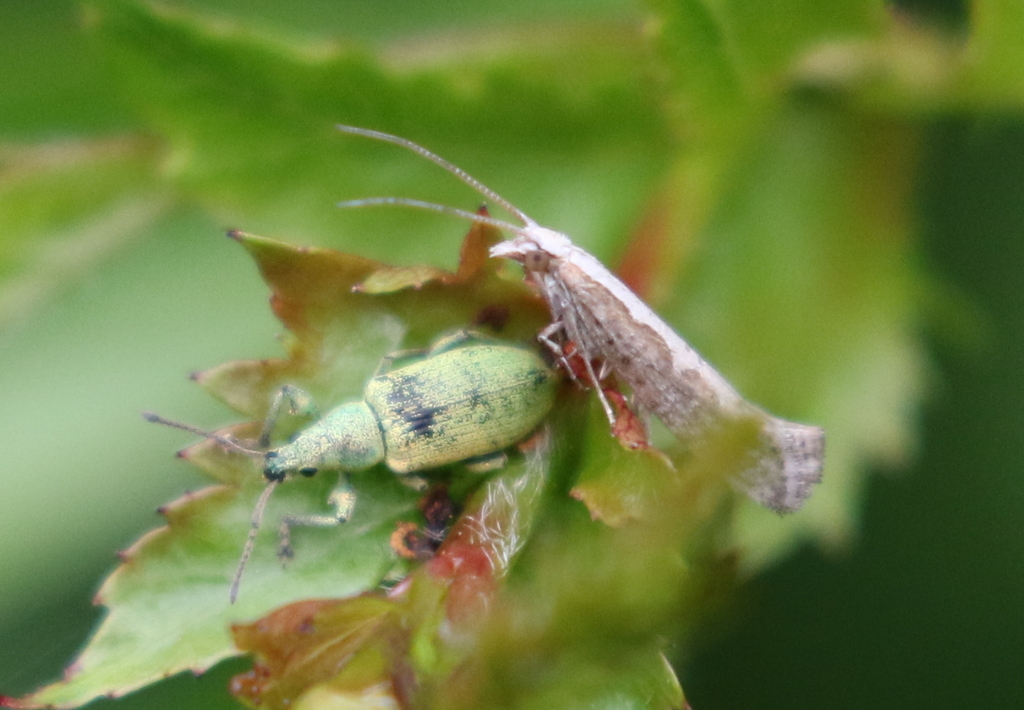
As we walked down the sheltered path between the hedges, lots of small moths came up out of the vegetation as we passed. We stopped to look at one and realised they were Diamond-back Moths, migrants from continent, presumably just arrived on the NE winds. There must have been at least 50 along this small stretch of path, a significant arrival. It was only later we discovered that there had been a big movement of them in recent days, with big numbers in Finland a week ago, arriving into Sweden just yesterday. Amazing to think of the huge distances these tiny moths had covered.
Back to birds, and a smart grey male Marsh Harrier circled up over the field beyond the path, before perching in the top of a hedge where we could get a good look at it through the scope. A second male then drifted in over the valley too.

A Lesser Whitethroat was singing just across the road, and it was good to get a better chance to hear its distinctive rattling song than the one we had looked for this morning. It was sheltered here and there were a few other birds singing. A bright male Yellowhammer perched in the top of a pine tree singing and a Chiffchaff was singing from the trees further along.
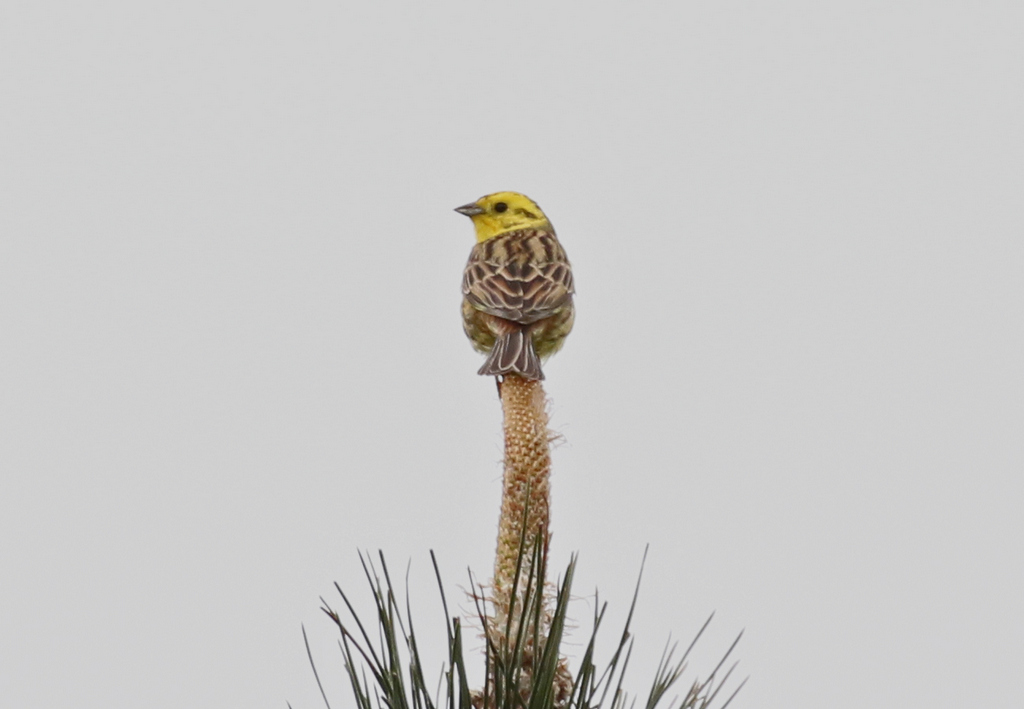
The bushes down alongside the river were quieter this afternoon – it seemed like most of the birds were round on the more sheltered side of the trees. A Cetti’s Warbler shouted at us from deep in cover. A pair of Marsh Harriers circled up from the near corner of the Fen, and we watched the male fly out across the middle of the pool, stirring up all the Avocets which flew up to mob it.
From up on the seawall, we had a better view of the Fen. A Common Sandpiper was working its way around the muddy edges of the islands and over twenty Black-tailed Godwits were gathered down in the water in the near corner, feeding.
Looking out across the harbour, the tide was coming in. There were lots more Brent Geese out on the saltmarsh and we could see the seals on Blakeney Point beyond. Scanning the edge of the harbour from the seawall, we could see a few waders gathering around the edge – mostly Oystercatchers, but a little group of Dunlin were new for the day, we could see their black belly patches in the scope.
It was cool out here, exposed to the wind which wasn’t especially strong but had a distinct chill to it. We decided not to walk out to the edge of the harbour – it was time to head back now anyway. Back at the minibus, the Brent Geese were now gathering in the field with the scarecrow and the bird scarer, several hundred of them with more flying in as we packed up.
















